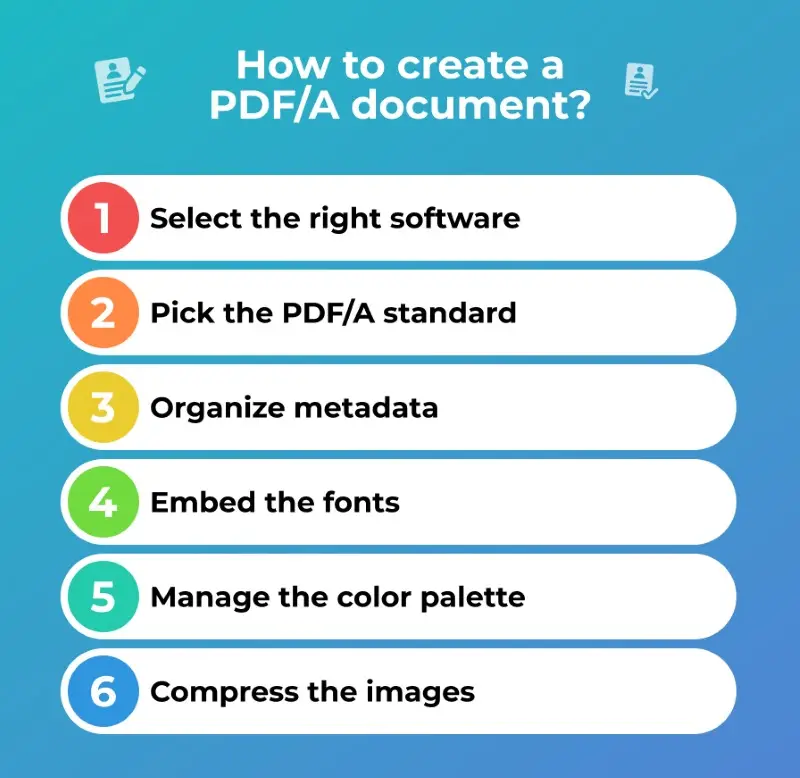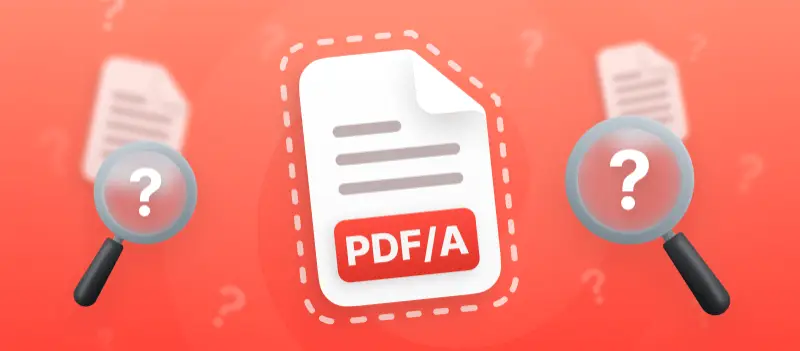Nowadays, digital technology is developing very quickly. Some document formats that were relevant 20 years ago aren't supported on modern devices and operating systems. If you want your PDF documents to remain accessible in the future, you may need to use PDF/A format.
This could be important for creative professionals like graphic designers, photographers, and videographers, as well as anyone who needs to store records such as financial statements or medical papers.
All those who must archive digital documents for long-term storage should read this article to learn more about PDF/A format.
What is a PDF/A format?
PDF/A is a file format standard for the long-term archiving of electronic documents. The "A" stands for "Archive".
This format is designed to ensure that electronic documents can be preserved in their original format over time, making them suitable for digital preservation and reliable long-term storage.
- PDF/A files are self-contained and store all the data necessary for displaying the document, including fonts and images.
- They are also smaller than their regular PDF equivalents as PDF/A contains no unnecessary data. This ensures that documents can be opened and read similarly now and later.
PDF vs PDF/A
Regular PDF files are designed for sharing documents in a standard format across multiple platforms and applications.
- They may have features such as password protection, encryption, annotations, audio, video, 3D objects, and hyperlinks. This type of PDF is not optimized for preservation.
PDF/A is an ISO-standardized adaptation of PDF, crafted for the digital safeguarding of records.
- It is an archival format of PDF that embeds all elements it contains such as fonts, colors, and metadata.
Here is the main difference between PDF and PDF/A:
| PDF/A | ||
|---|---|---|
| File Structure | PDF/A files must meet certain file structure requirements to ensure long-term preservation. | PDFs don't have to follow any specific structure. |
| Metadata | PDF/A requires certain metadata attributes to be included in the storing file. | Normal PDFs may or may not have this metadata. You can edit PDF metadata using an online service. |
| Fonts | Fonts used in PDF/A have to be embedded in the file for them to remain legible throughout. | PDFs do not require to embed fonts for readability. |
| Security Settings | Security settings have to be turned off in a PDF/A file to ensure that it will still be usable in several years. | Regular PDF can have security settings enabled but this may limit access to it. |
| Colors | Colors used in a PDF/A document must be specified using either RGB or CMYK color spaces. | Standard PDFs are capable of using any color space, which could lead to unexpected results when viewed on different devices over time. |
Creating PDF/A documents
Making PDF/A-compliant documents involves following specific guidelines and using tools that support this standard.
Here's a step-by-step guide to help you:
- Ensure that the software you are using to create PDF documents supports this standard. Many popular programs, such as Adobe Acrobat, offer options to save documents in the PDF/A format.
- Choose the specific PDF/A standard you want to adhere to. The guide on each standard will be provided below in this article.
- Set the document properties such as title, author, subject, and keywords. This data is crucial for long-term archiving.
- Ensure that all fonts used in the document are embedded.
- If your document contains color, manage it according to the PDF/A standard.
- Use lossless compression for images or follow the compression guidelines specified by the PDF/A standard. JPEG 2000 is allowed in PDF/A-2 and later versions.

What are the different types of PDF/A?
There are three main kinds of PDF/A:
- PDF/A-1 is the original standard for archival documents and is developed to guarantee document consistency over a long time period. It includes features such as fonts, color spaces, and metadata.
- PDF/A-2 was released in 2011 and has all the features from PDF/A-1. This version supports non-embedded fonts, as well as more complex elements such as forms, annotations, and layers.
- PDF/A-3 released in 2012 adds support for embedded audio, video, 3D objects, and other types of interactive content. It also supports multiple file attachments and layers within a single document.
Depending on your specific needs, one type may be better suited than another for creating archivable PDF documents.
Technical specifications
Conformance Levels
PDF/A standards have different conformance levels, such as PDF/A-1a, PDF/A-1b, PDF/A-2a, etc. These levels define specific requirements and options within each standard that must be followed for compliance.
Metadata and Tagging
PDF/A standards often specify requirements for metadata, ensuring that essential information about the document is embedded for future accessibility. Tagging structures are designed to enhance accessibility for users with disabilities.
Compression
PDF/A supports compression methods to reduce the file size of documents. However, it mandates the use of lossless compression to ensure that no information is lost during the process.
Embedded Files
PDF/A-2 and PDF/A-3 allow the embedding of non-PDF/A files, expanding the range of content that can be included in a compliant document.
Advantages of PDF/A format
PDF/A offers a range of benefits to its users, including:
- Long-term storage. PDF/A ensures documents remain readable and consistent over time. This makes it perfect for archiving important paperwork and records.
- Compatibility. PDF/A is compatible with a wide range of devices, operating systems, and software applications. This means that files can be shared through various systems, with no need for additional conversions.
- Image preservation. PDF/A preserves images in their original form, without loss in quality. This is great for storing or printing images and photographs.
- Searchability. Files in PDF/A format are easy to search for keywords, tags, or phrases. This simplifies the task of locating specific files in large archives.
Overall, PDF/A provides a secure and reliable way to preserve documents over long periods of time, while also offering compatibility across different platforms and devices.
Common use cases for PDF/A
| Sphere | Use case |
|---|---|
| Legal Documents and Records. | Legal professionals use PDF/A to archive contracts, court documents, and other records. The format's ability to maintain document integrity is crucial for legal compliance and future reference. |
| Government Records and Compliance. | Government agencies leverage such files for archiving and managing public records. Compliance with regulatory standards is often a requirement, and PDF/A format helps ensure the accessibility and authenticity of electronic documents. |
| Healthcare and Medical Records. | PDF/A is employed in the healthcare sector for storing electronic medical records (EMRs) and other documents. It supports the long-term preservation of patient information and medical histories. |
| Financial Documents and Statements. | In the financial industry, PDF/A is used to archive financial statements, invoices, and transaction records. Compliance with accounting and auditing standards is facilitated by the ability to save document integrity. |
| Technical Documentation. | Industries dealing with engineering drawings, technical specifications, and manufacturing documentation use PDF/A to preserve critical documents. It ensures that technical information remains accurate and accessible over time. |
| Academic Papers. | Academic institutions and researchers use PDF/A to archive and preserve research papers, theses, and scholarly publications. The format ensures that research work remains accessible and visually consistent. |
| Real Estate Documents. | Real estate professionals use PDF/A for archiving property-related documents, including contracts, deeds, and legal agreements. It ensures the preservation of important records related to real estate transactions. |
| Cultural Heritage Institutions. | Libraries and cultural institutions use PDF/A files to preserve digital manuscripts, rare books, and other heritage documents. It helps safeguard valuable historical and cultural materials in digital form. |
Accessibility features in PDF/A
1. Assistive Technologies
PDF/A mandates that documents be "tagged," organizing content in a structured format that facilitates navigation with assistive tools, such as screen readers.
Tags identify elements like headings, paragraphs, lists, and tables, enabling smooth reading for users with visual impairments.
- Headings: Clearly defines document sections for easy navigation.
- Tables: Ensures logical reading order for tables, including headers for rows and columns.
2. Text-to-Speech Support
By embedding fonts and preserving text data, PDF/A enables compatibility with TTS software. This ensures that those with visual impairments can access written material audibly, providing greater independence and understanding.
3. Alternative Text for Visual Content
To support users with visual disabilities, PDF/A requires images, charts, and diagrams to include alternative text. This allows screen readers to describe the visual content, so these elements convey meaning to all people.
FAQ
Is PDF/A compatible with other formats?
Yes, PDF/A is operable with different types of files including JPEG and TIFF. Files stored in these formats can be converted to PDF/A for archiving purposes. It can even be used to convert paper documents into digital form for easy storage and retrieval.
Is there a way to convert an existing PDF document to meet PDF/A standards?
Yes, several services like Adobe Acrobat Pro allow the transformation of PDF documents into a compatible version of PDF/A.
These tools allow users to remove any unsupported features from an existing file. That way it meets the requirements of long-term preservation and can remain read over time without alteration or deterioration.
If you need to store PDF but don't want to convert it to PDF/A you can use online PDF compressor to shrink it and remove unnecessary data.
Can I edit a document that's been stored in PDF/A format?
No, once a document has been converted to PDF/A it cannot be edited. Any changes will break its compliance status and render it unreadable over the years. If you need to make any changes you will have to convert the document to regular PDF and back to PDF/A afterwards if necessary.
Conclusion
PDF/A is a powerful file format that can help you create high-quality documents for print or digital use. You can ensure that your documents will remain accessible and be easy to share with others. With PDF/A, you can have peace of mind knowing your important data will be safe and sound.
Use other free online PDF tools:
- Compress PDF to reduce its size.
- Convert PDF to other formats and back.
- Crop PDF pages for your convenience.
- Edit PDF metadata easily in your browser.




